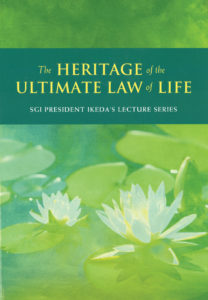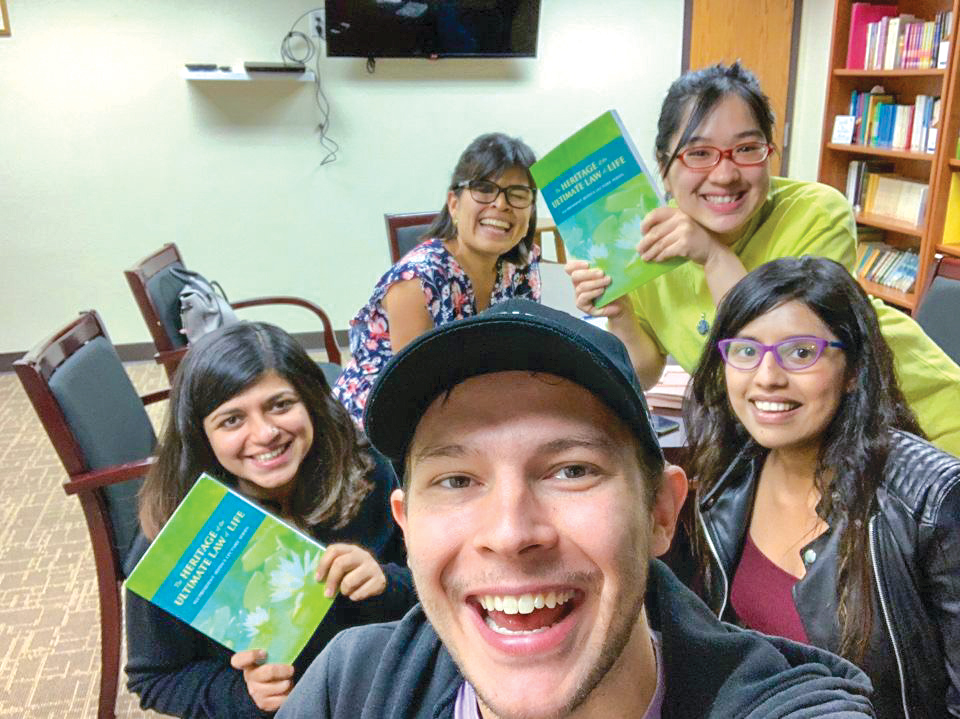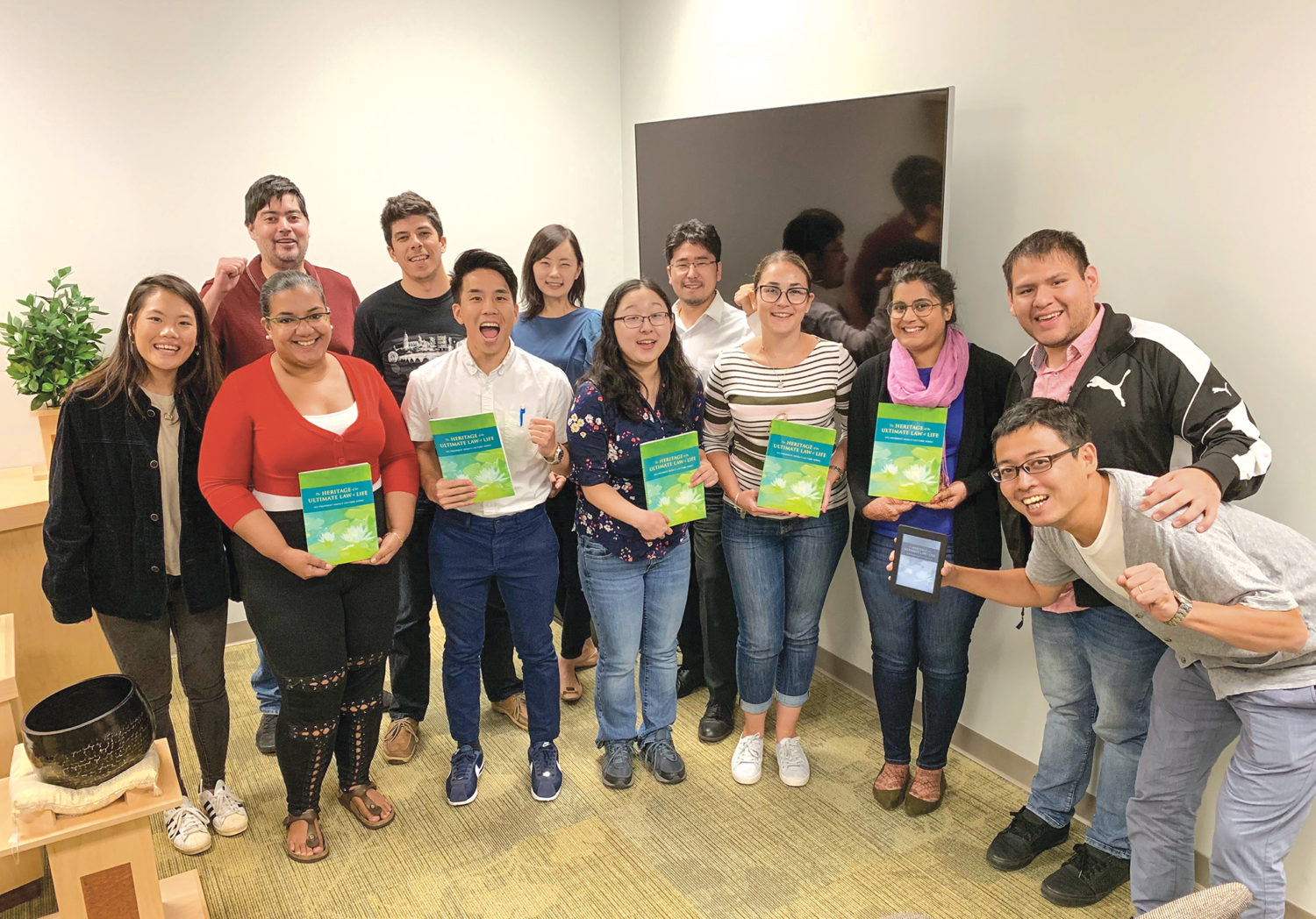The Ikeda Wisdom Academy is an SGI-USA youth division movement to engage youth leaders in advanced study. This month, academy members will study chapter 5 of The Heritage of the Ultimate Law of Life: SGI President Ikeda’s Lecture Series.
While the Ikeda Wisdom Academy is a youth leaders study program, all SGI-USA members are invited to utilize this section of Living Buddhism as a guide for their personal study of “The Heritage of the Ultimate Law of Life.”
– – – – – – – – – – – – – – – – – – – – – – – – – – – –
Syllabus – November 2019
The Heritage of the Ultimate Law of Life: SGI President Ikeda’s Lecture Series, Chapter 5
– – – – – – – – – – – – – – – – – – – – – – – – – – – –
Chapter 5
Embracing Myoho-renge-kyo—Striving to Fulfill the Great Vow for Kosen-rufu Is the Key to Birth and Death in the Realm of Buddhahood

Nichiren Daishonin underscores the importance of awakening to the true nature of life and death to activate the transformative power of the Mystic Law. He asserts that the key to tapping into the ultimate power of the universe is to strive to awaken all people to the ultimate law of life and death.
Transforming Birth and Death in the Realm of Delusion and Attaining an Inner State of Peace and Tranquillity
The life and death of all living beings are inherently functions of Myoho-renge-kyo, but when our minds are clouded by ignorance, causing us to become confused and attached to worldly desires, we cannot correctly apprehend this truth and instead cling to deluded views of existence. But in the light of the Buddha wisdom that perceives the true aspect of living beings in the threefold world—as described in “Life Span,” the 16th chapter of the Lotus Sutra—the view of life and death held by ordinary people shows itself to be nothing but an illusion.
■ ■ ■
When we undergo the cycle of birth and death in the realm of Buddhahood, both life and death shine with unsurpassed brilliance as functions of Myoho-renge-kyo. During the manifest phase of life, the pure life essence of Buddhahood wells forth within us, serving as a powerful source of strength for combating difficulties; it is the engine for overcoming all hardships and building a victorious life. When we bring forth our innate Buddhahood and valiantly grapple with reality, we forge and polish our lives which, when our mission in this existence is completed, will merge into the Buddhahood of the universe. Not only do we enter a state of limitless joy and vast and unbounded freedom, we also become one with the compassion inherent in the universe. This compassionate impulse of the universe directs us toward embarking on another new vibrant existence in the reality of the threefold world in order to lead those who are suffering to enlightenment. In this way, our lives repeatedly undergo birth and death in the realm of Buddhahood.
When we undergo birth and death in the realm of Buddhahood, the latent phase of death becomes a period of replenishment for our next life, much like a good night’s sleep gives us fresh energy and vitality for the new day.
Nichiren Daishonin writes: “When he was alive, he was a Buddha in life, and now he is a Buddha in death. He is a Buddha in both life and death. This is what is meant by that most important doctrine called attaining Buddhahood in one’s present form” (“Hell Is the Land of Tranquil Light,” The Writings of Nichiren Daishonin, vol. 1, p. 456). Both in life and death we are Buddhas—this is the meaning of undergoing the cycle of birth and death in the realm of Buddhahood. (The Heritage of the Ultimate Law of Life: SGI President Ikeda’s Lecture Series, pp. 42–43)

Denver IWA
Faith for Inheriting the Ultimate Law of Life and Death
“Shakyamuni Buddha who attained enlightenment countless kalpas ago, the Lotus Sutra that leads all people to Buddhahood, and we ordinary human beings are in no way different or separate from one another. To chant Myoho-renge-kyo with this realization is to inherit the ultimate Law of life and death. This is a matter of the utmost importance for Nichiren’s disciples and lay supporters, and this is what it means to embrace the Lotus Sutra” (“The Heritage of the Ultimate Law of Life,” WND-1, 216).
As disciples of Nichiren Daishonin, what is the proper way for us to embrace Nam-myoho-renge-kyo—the ultimate Law of life and death—so that we can undergo the cycle of birth and death in the realm of Buddhahood? Nichiren addresses this question on various levels, clarifying the essential points of faith in the Mystic Law.
The first of these is that our faith must be based on the recognition that birth and death in the realm of Buddhahood is the original and inherent nature of our own existence. Nichiren explains: “Shakyamuni Buddha who attained enlightenment countless kalpas ago, the Lotus Sutra that leads all people to Buddhahood, and we ordinary human beings are in no way different or separate from one another. To chant Myoho-renge-kyo with this realization is to inherit the ultimate Law of life and death” (WND-1, 216).
Nichiren’s assertion here of the inherent equality and oneness of all three—Shakyamuni Buddha, the Lotus Sutra and ordinary people—is extremely important.
Also, to awaken ordinary people to the inherent truth of birth and death in the realm of Buddha-hood, both the actual example of the Buddha who embodies this truth and the teaching or Law that explains this truth are vital.
Now let’s examine each of the three components mentioned in the above passage from Nichiren’s letter. (Lecture Series, 43–44)
1) “Shakyamuni Buddha Who Attained Enlightenment Countless Kalpas Ago”: An Embodiment of Birth and Death in the Realm of Buddhahood
The Shakyamuni who attained enlightenment for the first time under the bodhi tree in India and the Shakyamuni who attained enlightenment in the remote past differ not only in the length of their life spans but also as to the view of birth and death they each embody. The former is a Buddha who aspires to break free from the cycle of birth and death and attain the eternal realm of nirvana. The latter, however, is a Buddha who eternally undergoes the cycle of birth and death in the realm of Buddhahood in order to teach and convert living beings in the saha world (this world in which we endure continual sufferings).
Consequently, although various Buddhas are described in the sutras, it is not until Shakyamuni reveals in the Lotus Sutra that he attained enlightenment in the remote past that the inherent truth of birth and death in the realm of Buddhahood is established. Shakyamuni as the Buddha enlightened since the remote past can therefore be considered the embodiment of this inherent truth. (Lecture Series, 44)
2) “The Lotus Sutra That Leads All People to Buddhahood”: A Teaching for Realizing Birth and Death in the Realm of Buddhahood
It goes without saying that the primary meaning of this phrase is that the doctrine of universal enlightenment is found only in this sutra. At the same time, the Lotus Sutra elucidates the Buddha’s original vow—a vow of eternal dedication to the cause of helping all living beings attain Buddhahood—as well as the vow of bodhisattvas who pledge to strive alongside the Buddha for this same cause, carrying out the practice of compassion. This could be said to represent the true significance of the Lotus Sutra, the quintessence of the Mahayana teachings.
■ ■ ■
Striving to fulfill the vow to lead all people to enlightenment is a concrete realization of our following the path of birth and death in the realm of Buddhahood. We must awaken to the fact that this noble vow is the very essence of our beings. Forgetting this vow and failing to seek the ultimate truth is a fundamental cause of delusion.
The Lotus Sutra reveals that all people have the potential to attain Buddhahood. In other words, it is a teaching that makes it possible for every individual to fulfill life’s true purpose by acting in accord with the compassionate workings of the universe.
As outlined above, “the Lotus Sutra that leads all people to Buddhahood” indicates the Lotus Sutra not only as a teaching of universal enlightenment but also as an appeal to translate the vow for universal enlightenment into action. The Lotus Sutra thus teaches both the principle that all people are Buddhas and also the practice to guide and help awaken them to their inherent Buddhahood. (Lecture Series, 44–46)
3) “We Ordinary Human Beings”: Our Oneness With the Buddha and the Law
There is no difference or distinction among our lives, the Buddha and the Law. To believe that there is, even in the slightest, is a manifestation of delusion arising from our innate ignorance to life’s ultimate truth. Only when we comprehend that we are entities that undergo birth and death in the realm of Buddhahood can we be said to be truly practicing Nichiren Buddhism.
Nichiren Daishonin says we must chant Myoho-renge-kyo with the realization that we are in no way different or separate from the Buddha and the Law (see WND-1, 216). Here, realization does not simply mean an intellectual appreciation but rather belief and understanding—that is, an understanding based on belief, or a heartfelt acceptance and conviction in the depths of one’s life. This is essential.
Such profound inner conviction is forged through efforts to lead others to enlightenment with the spirit of not begrudging one’s life. SGI members who have dedicated themselves tirelessly for the sake of kosen-rufu with resolute faith have, in the course of their struggles, gained a strong and vibrant belief and understanding. They are dedicating themselves to the mission of spreading Nam-myoho-renge-kyo as Bodhisattvas of the Earth and striving to do their very best. As such, they are already manifesting the vast and expansive life state of Buddhahood of Nam-myoho-renge-kyo equal in every way to that revealed by “Shakyamuni Buddha who attained enlightenment countless kalpas ago” and “the Lotus Sutra that leads all people to enlightenment.” Each individual, as an entity of the Mystic Law, is powerfully manifesting the life state of Nichiren Daishonin embodied in the Gohonzon and living out his or her life in harmony with the Mystic Law.
When we make our lives one with the Mystic Law in this lifetime, we remain so after death and, on our next rebirth, we will dedicate ourselves once more to fulfilling our mission for the Mystic Law. This is the inherent nature of birth and death in the realm of Buddhahood. And it is the essence of a life that forever strives to manifest the workings of compassion.
■ ■ ■
What is the fundamental path of faith for a disciple? It is to dedicate oneself to kosen-rufu, which is the wish of all Buddhas as well as Nichiren’s great desire. It is to dedicate oneself to practicing the spirit of the Lotus Sutra—in other words, making efforts to help guide all people to enlightenment. (Lecture Series, 46–47)
The True Way of “Embracing the Lotus Sutra”
When we chant Nam-myoho-renge-kyo with the same great spirit and great desire for kosen-rufu as Nichiren Daishonin, we can experience birth and death in the realm of Buddhahood and tap the fundamental life force that resides within us. The Lotus Sutra (Nam-myoho-renge-kyo) has the power to rejuvenate and revitalize our lives. Through its power, in life, we can grow younger and accumulate good fortune, while in death, we can merge with the vast realm of Buddhahood of the universe as a whole and recharge our vital life force.
■ ■ ■
Because, as practitioners of Nichiren Buddhism, we live our lives in direct accord with the essential way of life of Buddhas, we overflow with innate life force. Because we carry out efforts that embody the workings of compassion of time without beginning, we can remain basically joyful and positive, no matter what happens. And because we, who uphold the Soka spirit of mentor and disciple, follow the path of birth and death in the realm of Buddhahood, our lives are strong and invincible. As SGI members, who possess a sound and undistorted view of life and death, we are people of wisdom and true philosophy, people of courage and genuine commitment. (Lecture Series, 47–48)
You are reading {{ meterCount }} of {{ meterMax }} free premium articles

